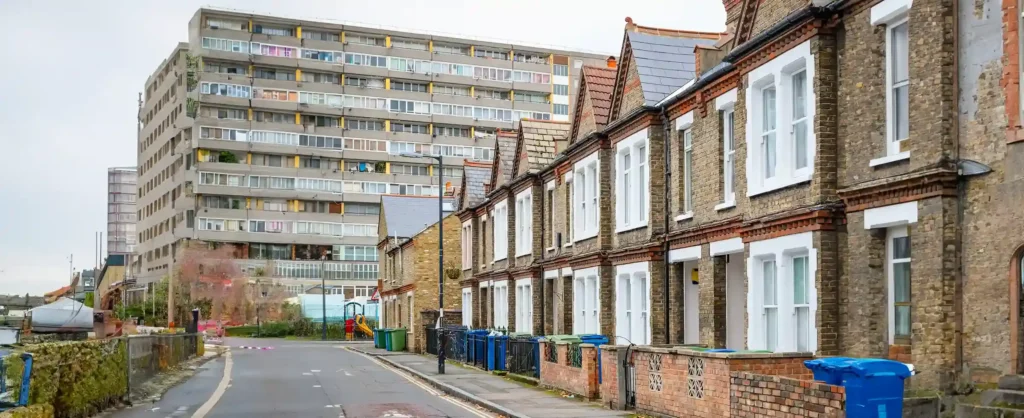Austerity has been an increasingly unavoidable reality for many caught in the turbulence of the cost of living crisis. And, while none can deny that low-income households have been the most heavily impacted by public service cuts and inflation, the middle class is experiencing its fair share of turmoil alongside it. Due in no small part to mounting housing costs and housing affordability issues, middle-income earners on salaries as comfortable as £60,000 a year are struggling to make ends meet.
Beyond the cost of living and housing affordability issues, however, the difficulties faced by the middle class have deeper implications. As middle-income earners move towards the poverty line, the divide between the rich and the poor widens. The result could well mean the disappearance of the middle class as we know it.
With no end in sight for the cost of living crisis, will housing costs spell doom for the middle class? And, if so, what can we as housing market stakeholders do to help keep middle-income earners afloat?
Why Middle Class Housing Costs Are Such an Issue
A recent article from The Guardian ruled that the two primary factors in financial hardship for the UK’s middle-income earners are an insecure job market and high housing costs. As a result, 20% of those in the middle fifth bracket of income distribution are struggling to pay for food and other essential items. The same article found that one in seven middle-income earners was in insecure housing, the unaffordability of which has compounded other costs to threaten one in three with being moved to a lower quintile by the end of 2024.
The impact of rising housing costs on the middle class is not strictly limited to day-to-day expenditure. According to a report by the abrdn Financial Fairness Trust, rising interest and mortgage rates mean the proportion of houses with unaffordable mortgages could almost double from 10% to 19% for the average middle-income earner. If this happens, one in ten middle-income earners may fall below the poverty line due to housing affordability. Currently, the ratio of debt to GDP rose above 100% for the first time since 1961 last year, signalling that mortgage rates and borrowing will likely worsen for everyone in the next few years, not just middle-income earners.
Rising housing costs play a prominent role in pushing the middle class toward poverty. A 2022 report on housing costs by the Institute for Fiscal Services (IFS) revealed the poverty rate in the UK was 17% using incomes measured before housing cost deductions, rising to 22% after factoring them in. And, with the Organisation for Economic Co-operation and Development (OECD) estimating that 40% of middle-income households are “financially vulnerable” and are either in arrears or would not be able to absorb sudden financial difficulty, it may not take much of a final straw to break the camel’s back.
Breaking Down the Breakdown of Housing Costs
The housing costs affecting the middle class can be broken down into three distinct subcategories.
The Cost of Living in Property
A 2023 Resolution Foundation survey revealed that working-age respondents were more than twice as likely to report that their pay had risen since October 2022, but 24% of pay rises did not keep pace with inflation. This has significantly worsened the cost of living for middle-income workers. So much so that the Guardian reported 600,000 people had been pushed below the poverty line in 2023. Perhaps as a result, a record 6.7 million Brits are currently facing financial difficulty.
Last year’s hike in energy prices has also hurt the cost of living for the average household, with the Citizens Advice Bureau reporting record numbers of households struggling to manage debt.
As data from Which.com confirms, the number of working and middle class households defaulting on essential bill payments saw a sharp increase towards the end of last year, with one in ten claiming they had missed payments on loans or household bills in November 2023.
Renting and Owning Property
According to a recent article from The Guardian covering Office for National Statistics (ONS) findings, the average monthly rent paid by tenants in the UK rose by 9% in the year to February. This increase marks the highest annual rise since records began and is partly due to a recent acceleration in rent pricing caused by higher interest costs for landlords and a fall in the number of available rental properties.
Likewise, the Resolution Foundation predicts that homeowners remortgaging this year will see their payments rise by an annual average of £1,800 thanks to last year’s mortgage crisis, with housing costs for mortgaged households rising by 23% on average. This “financial squeeze” may cause the average UK household to be £1,900 poorer by January 2025 than pre-COVID in December 2019.
Purchasing Property
House prices have risen significantly in the past several years. According to an ONS bulletin, the average house price was £275,000 in the financial year ending in 2022 while the average disposable household income was £33,000. This equates to a ratio of 8.4 years of income needed to purchase the average home. The same bulletin further highlights that the average home in every country in the UK sold for more than five years’ worth of the average income, falling beneath the threshold established for positive housing affordability. In England, only households in the top 10% of income could afford an average home with fewer than five years of income in 2022. And, with average disposable income falling 44% between 2022-23, housing will likely be more unaffordable throughout 2024.
A further article from the Guardian suggests that, up until 2021, the median household could still afford to buy a house in the cheapest 20% of the market. Since 2021, however, house prices have increased significantly faster than income. Now, middle-income earners can only afford the cheapest 10% of properties. Moreover, the affordability ratio of lower earnings to lower-priced homes ended up being better than the ratio of median earnings to median-priced homes, suggesting that middle class homes were less affordable for middle-income earners than lower-class homes were for low-income households.
Within the ‘Anglosphere’ made up of Australia, Canada, New Zealand, the United States and the United Kingdom, the UK spends more on housing than every country besides the United States. It also performs worse than most European countries in housing affordability.
Across the board, housing costs have mounted to create an untenable situation for the average household that puts the middle class at risk of permanent collapse.
How Affordable Housing Keeps the Middle Class Afloat
We may work exclusively to provide housing for vulnerable and low-income tenants at Concept Capital Group but, with the recent fall in housing supply and mounting demand for permanent property, the housing market could easily benefit from a focus on affordable housebuilding. A report from the Mayor of London’s official website links affordable housing supply to a general increase in housing affordability and availability at all income levels. Such housebuilding can also drive down housing costs, which can help to keep middle-income earners, and the middle class as a whole, less exposed to financial risk.
Interested in investing in affordable social housebuilding? You can find out more about our homes by booking a call with our team today.













